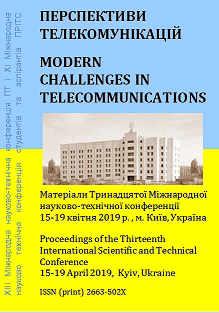ПІДХІД ДО ПОБУДОВИ СИСТЕМИ ПОВТОРНОЇ ІДЕНТИФІКАЦІЇ ЛЮДЕЙ В ПРИМІЩЕННІ
Ключові слова:
ІДЕНТИФІКАЦІЯ ЛЮДЕЙ, ПОБУДОВА СИСТЕМАнотація
Approach for building an indoor person re-identification system
In this paper, we propose the whole pipeline of person re-identification system. Re-identification problem is one of the oldest problems in computer vision. The main contributions of the paper first are describing challenges during building and adjusting system and second is the approach for choosing the main parts of re-identification pipeline based on research and production experience.
В останні роки спостерігається підвищена зацікавленість до систем повторної ідентифікації в області безпеки та персоналізації послуг різними установами. Для забезпечення безпеки найбільш широко використовуються системи ідентифікації на основі електромагнітних перепусток. Їх недоліки це відсутність гарантії того що перепустка не попаде до сторонніх осіб та не буде підроблена. Для покращення надання персоналізованих послуг використовуються картки лояльності. Проблема пов’язана із картами лояльності - складність їх поширення. Тому для вирішення задачі повторної ідентифікації зростає зацікавленість в системах, які базуються на комп’ютерному зорі.В даній роботі було взято за мету проаналізувати складові для системи комп’ютерного зору повторної ідентифікації (СКЗПІ), описати основні проблеми при їх побудові та описати розроблену СКЗПІ.
Посилання
Kaipeng Zhang, Zhanpeng Zhang, Zhifeng Li, Yu Qiao “Joint Face Detection and Alignment using Multi-task Cascaded Convolutional Networks”. arXiv:1604.02878, 2016.
Wei Liu, Dragomir Anguelov, Dumitru Erhan, Christian Szegedy, Scott Reed, Cheng-Yang Fu, Alexander C. Berg “SSD: Single Shot MultiBox Detector”. arXiv:1512.02325, 2016.
Joseph Redmon, Santosh Divvala, Ross Girshick, Ali Farhadi “You Only Look Once: Unified, Real-Time Object Detection”. arXiv:1506.02640, 2015.
Carlo Tomasi and Takeo Kanade. Detection and Tracking of Point Features. Carnegie Mellon University Technical Report CMU-CS-91-132, April 1991.
E. Bochinski, V. Eiselein, T. Sikora. High-Speed Tracking-by-Detection Without Using Image Information. In International Workshop on Traffic and Street Surveillance for Safety and Security at IEEE AVSS 2017, 2017.
A. Krizhevsky, I. Sutskever, and G. Hinton ”Imagenet classification with deep convolutional neural networks”. InNIPS, 2012.
Kaiming He, Xiangyu Zhang, Shaoqing Ren, Jian Sun “Deep Residual Learning for Image Recognition”. arXiv:1512.03385, 2015.
Rajeev Ranjan, Carlos D. Castillo, Rama Chellappa “L2-constrained Softmax Loss for Discriminative Face Verification”. arXiv:1703.09507, 2017.
Yandong Wen, Kaipeng Zhang, Zhifeng Li and Yu Qiao. A Discriminative Feature Learning Approach for Deep Face Recognition. The Chinese University of Hong Kong, Sha Tin, Hong Kong, 2016.
Florian Schroff, Dmitry Kalenichenko, James Philbin “FaceNet: A Unified Embedding for Face Recognition and Clustering”. arXiv:1503.03832, 2015.
Cover TM, Hart PE (1967). Nearest neighbor pattern classification. IEEE Transactions on Information Theory. 13 (1): 21–27.
Johnson, Jeff and Douze, Matthijs and J'egou, Herv'e “Billion-scale similarity search with GPUs”. arXiv:1702.08734, 2017.
Sebastian Ruder “An Overview of Multi-Task Learning in Deep Neural Networks”. arXiv:1706.05098, 2017.
Yang, Shuo and Luo, Ping and Loy, Chen Change and Tang, Xiaoou. WIDER FACE: A Face Detection Benchmark. IEEE Conference on Computer Vision and Pattern Recognition (CVPR), 2016.
Anna Veronika Dorogush, Vasily Ershov, Andrey Gulin "CatBoost: gradient boosting with categorical features support". Workshop on ML Systems at NIPS 2017.
##submission.downloads##
Як цитувати
Номер
Розділ
Ліцензія
Авторське право (c) 2019 Максим Станіславович Остапенко, Олена Сергіївна Штогріна

Ця робота ліцензується відповідно до Creative Commons Attribution 4.0 International License.
Authors who submit to this conference agree to the following terms:a) Authors retain copyright over their work, while allowing the conference to place this unpublished work under a Creative Commons Attribution License, which allows others to freely access, use, and share the work, with an acknowledgement of the work's authorship and its initial presentation at this conference.
b) Authors are able to waive the terms of the CC license and enter into separate, additional contractual arrangements for the non-exclusive distribution and subsequent publication of this work (e.g., publish a revised version in a journal, post it to an institutional repository or publish it in a book), with an acknowledgement of its initial presentation at this conference.
c) In addition, authors are encouraged to post and share their work online (e.g., in institutional repositories or on their website) at any point before and after the conference.

